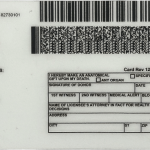In the maritime industry, crew identification is of utmost importance for a variety of reasons. It ensures safety on board vessels, helps in efficient management of the crew, and is crucial for compliance with various regulations. However, as we approach 2025, the issue of fake IDs is emerging as a significant challenge for this identification process.
### The Current State of Crew Identification in the Maritime Industry
Currently, the maritime industry relies on a range of identification methods for its crew. These include traditional documents such as passports, seaman’s books, and identity cards issued by relevant authorities. These documents contain vital information about the crew member, including their name, date – of – birth, nationality, and a photograph for visual identification. Additionally, many vessels are now implementing biometric identification systems, such as fingerprint or iris scanners, to add an extra layer of security.
These identification methods have served the industry well for many years, but with the advancement of technology, the threat of fake IDs has become more prominent. Fraudsters are using sophisticated techniques to create counterfeit documents that are often difficult to distinguish from the real ones at first glance.
### The Rise of Fake IDs in 2025 and Its Impact on the Maritime Industry
By 2025, it is expected that the problem of fake IDs will have grown exponentially. The availability of high – end printing and scanning technology, along with the increasing sophistication of digital manipulation tools, has made it easier for criminals to produce fake identification documents. In the maritime industry, this has several far – reaching consequences.
One of the most significant impacts is on safety. A crew member with a fake ID may not have the necessary qualifications, training, or experience required for their assigned role. This could lead to accidents, as they may not be able to handle emergency situations properly or perform their duties with the required level of competence. For example, a fake – ID holder posing as a ship’s engineer may not be able to diagnose and fix mechanical problems on the vessel, potentially endangering the lives of all on board.
Fake IDs also pose a security risk. Crew members with false identities could be involved in illegal activities such as smuggling, piracy, or terrorism. They could use their positions on the vessel to transport contraband goods, weapons, or even people across international borders. This not only violates maritime laws but also undermines the security of ports and coastal regions around the world.
Another aspect is the administrative and regulatory challenges. When fake IDs are detected, it can cause significant disruptions to the normal operations of a vessel. There may be delays in port clearance as authorities investigate the authenticity of the documents, which can result in financial losses for shipping companies due to demurrage charges and missed delivery schedules.
### Challenges in Detecting Fake IDs in the Maritime Industry
Detecting fake IDs in the maritime industry is no easy task. One of the main challenges is the sheer volume of crew members and vessels that need to be processed. Every day, thousands of ships dock at ports around the world, and each ship may have a large number of crew members. Verifying the authenticity of each identification document in a timely manner is a huge administrative burden.
The quality of fake IDs is also a major obstacle. Fraudsters are constantly improving their techniques, and some of the counterfeit documents are so well – made that they can pass initial visual inspections. For example, they may use high – quality paper, inks, and holograms that closely resemble those used in genuine documents. This requires port authorities and shipping companies to invest in advanced detection technologies and well – trained personnel to be able to spot the subtle differences.
There is also the issue of international cooperation. The maritime industry is a global business, and crew members come from all over the world. Different countries have different identification document standards and security features. Coordinating the verification of these documents across international borders can be complex and time – consuming. For instance, a seaman’s book issued by one country may have unique security features that are not well – known to authorities in another country, making it difficult to determine its authenticity.
### Strategies to Overcome the Challenges of Fake IDs in Crew Identification
To address the challenges posed by fake IDs, a multi – pronged approach is needed.
**Advanced Technology Adoption**: Shipping companies and port authorities should invest in state – of – the – art identification and verification technologies. This includes more advanced biometric systems, such as 3D fingerprint scanners and high – resolution iris recognition devices. These technologies are more difficult to deceive compared to traditional visual identification methods. Additionally, the use of blockchain technology can be explored for secure storage and sharing of crew identification information. Blockchain’s decentralized and immutable nature can prevent tampering of identification records.
**Enhanced Training for Personnel**: Personnel involved in crew identification, such as port security officers and shipping company staff, should receive comprehensive training on the latest fake ID detection techniques. This training should cover not only the physical examination of documents but also the use of advanced verification tools. They should be trained to recognize the security features of identification documents from different countries and be updated on the latest trends in fake ID production.
**International Collaboration**: There needs to be greater cooperation among countries in the maritime industry. This can involve the sharing of information on fake ID trends, the development of common standards for identification documents, and the establishment of a centralized database for crew identification verification. For example, countries could work together to create a global registry of seafarers with verified identities, which can be accessed by port authorities around the world for quick and accurate verification.
**Stricter Regulations and Penalties**: Governments and international maritime organizations should introduce stricter regulations regarding the use of fake IDs in the maritime industry. Penalties for individuals and organizations involved in the production, distribution, or use of fake identification documents should be severe. This will act as a deterrent and discourage potential fraudsters from engaging in such illegal activities.
### Common Problems and Solutions Related to Fake IDs in Maritime Crew Identification
#### Problem 1: Inadequate Document Verification Tools
**Solution**: Port authorities and shipping companies should invest in modern document verification equipment. This includes document scanners with built – in authentication features, such as ultraviolet (UV) light scanners to detect hidden security features in documents. Regularly update these tools to keep up with the latest security features of identification documents from different countries.
#### Problem 2: Lack of Awareness Among Crew Members
**Solution**: Conduct regular awareness campaigns for crew members about the importance of genuine identification and the risks associated with fake IDs. Provide training on how to protect their personal information and how to spot potential attempts at identity theft. This can be done through onboard seminars, online training modules, and informational brochures.
#### Problem 3: Difficulty in Verifying Digital Identities
**Solution**: Implement secure digital identity verification processes. This can involve the use of two – factor authentication methods for accessing digital identification systems. For example, in addition to a password, crew members may be required to provide a one – time code sent to their mobile devices. Also, use encryption techniques to protect the digital identity data from unauthorized access.
#### Problem 4: Slow and Inefficient International Verification Processes
**Solution**: Streamline international verification processes by establishing standardized data exchange protocols among countries. Create a network of trusted partners that can quickly verify crew identification information across borders. This could involve the use of secure online platforms where countries can share and access verified identification data in a timely manner.
#### Problem 5: High – Quality Counterfeit Documents Evading Detection
**Solution**: Continuously research and develop new detection technologies. This includes the use of artificial intelligence and machine learning algorithms to analyze the patterns and features of identification documents. These algorithms can be trained to recognize even the most subtle differences between genuine and fake documents. Additionally, encourage the development of new security features for identification documents that are more difficult to replicate, such as advanced holograms and embedded microchips.
Fake ID Pricing
unit price: $109
| Order Quantity | Price Per Card |
|---|---|
| 2-3 | $89 |
| 4-9 | $69 |
| 10+ | $66 |


